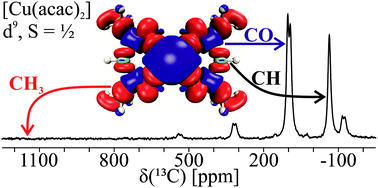当前位置:
X-MOL 学术
›
Phys. Chem. Chem. Phys.
›
论文详情
Our official English website, www.x-mol.net, welcomes your
feedback! (Note: you will need to create a separate account there.)
Remarkable reversal of 13C-NMR assignment in d1, d2 compared to d8, d9 acetylacetonate complexes: analysis and explanation based on solid-state MAS NMR and computations.
Physical Chemistry Chemical Physics ( IF 2.9 ) Pub Date : 2020-04-02 , DOI: 10.1039/d0cp00980f Anders B A Andersen 1 , Ari Pyykkönen 2 , Hans Jørgen Aa Jensen 1 , Vickie McKee 3 , Juha Vaara 2 , Ulla Gro Nielsen 1
Physical Chemistry Chemical Physics ( IF 2.9 ) Pub Date : 2020-04-02 , DOI: 10.1039/d0cp00980f Anders B A Andersen 1 , Ari Pyykkönen 2 , Hans Jørgen Aa Jensen 1 , Vickie McKee 3 , Juha Vaara 2 , Ulla Gro Nielsen 1
Affiliation

|
13C solid-state MAS NMR spectra of a series of paramagnetic metal acetylacetonate complexes; [VO(acac)2] (d1, S = ½), [V(acac)3] (d2, S = 1), [Ni(acac)2(H2O)2] (d8, S = 1), and [Cu(acac)2] (d9, S = ½), were assigned using modern NMR shielding calculations. This provided a reliable assignment of the chemical shifts and a qualitative insight into the hyperfine couplings. Our results show a reversal of the isotropic 13C shifts, δiso(13C), for CH3 and CO between the d1 and d2 versus the d8 and d9 acetylacetonate complexes. The CH3 shifts change from about -150 ppm (d1,2) to roughly 1000 ppm (d8,9), whereas the CO shifts decrease from 800 ppm to about 150 ppm for d1,2 and d8,9, respectively. This was rationalized by comparison of total spin-density plots and computed contact couplings to those corresponding to singly occupied molecular orbitals (SOMOs). This revealed the interplay between spin delocalization of the SOMOs and spin polarization of the lower-energy MOs, influenced by both the molecular symmetry and the d-electron configuration. A large positive chemical shift results from spin delocalization and spin polarization acting in the same direction, whereas their cancellation corresponds to a small shift. The SOMO(s) for the d8 and d9 complexes are σ-like, implying spin-delocalization on the CH3 and CO groups of the acac ligand, cancelled only for CO by spin polarization. In contrast, the SOMOs of the d1 and d2 systems are π-like and a large CO-shift results from spin polarization, which accounts for the reversed assignment of δiso(13C) for CH3 and CO.
中文翻译:

与d8,d9乙酰丙酮络合物相比,d1,d2中13C-NMR分配显着逆转:基于固态MAS NMR和计算的分析和解释。
一系列顺磁性金属乙酰丙酮配合物的13 C固态MAS NMR光谱;[VO(acac)2](d1,S =½),[V(acac)3](d2,S = 1),[Ni(acac)2(H2O)2](d8,S = 1)和[Cu(acac)2](d9,S = 1/2)是使用现代NMR屏蔽计算指定的。这提供了化学位移的可靠分配,并提供了对超精细偶联的定性见解。我们的结果表明,d1和d2与d8和d9乙酰丙酮配合物之间的CH3和CO的各向同性13C位移δiso(13C)逆转。对于d1,2和d8,9,CH3的变化从大约-150 ppm(d1,2)变为大约1000 ppm(d8,9),而CO的变化分别从800 ppm下降到大约150 ppm。通过比较总自旋密度图和计算出的与偶占分子轨道(SOMO)对应的接触耦合,可以使这一点合理化。这揭示了受分子对称性和d电子构型影响的SOMO自旋离域和低能MOs自旋极化之间的相互作用。大的正化学位移是由于自旋离域和自旋极化作用于相同方向而导致的,而它们的抵消对应于小位移。d8和d9配合物的SOMO呈σ状,这意味着在acac配体的CH3和CO基团上发生自旋离域化,仅被自旋极化抵消了CO。相比之下,d1和d2系统的SOMO呈π状,并且自旋极化导致大的CO位移,这解释了CH3和COδiso(13C)的反向分配。受分子对称性和d电子构型的影响。大的正化学位移是由于自旋离域和自旋极化作用于相同方向而导致的,而它们的抵消对应于小位移。d8和d9配合物的SOMO呈σ状,这意味着在acac配体的CH3和CO基团上发生自旋离域化,仅被自旋极化抵消了CO。相比之下,d1和d2系统的SOMO呈π状,并且自旋极化导致大的CO位移,这解释了CH3和COδiso(13C)的反向分配。受分子对称性和d电子构型的影响。大的正化学位移是由于自旋离域和自旋极化作用于相同方向而导致的,而它们的抵消对应于小位移。d8和d9配合物的SOMO呈σ状,这意味着在acac配体的CH3和CO基团上发生自旋离域化,仅被自旋极化抵消了CO。相比之下,d1和d2系统的SOMO呈π状,并且自旋极化导致大的CO位移,这解释了CH3和COδiso(13C)的反向分配。d8和d9配合物的SOMO呈σ状,这意味着在acac配体的CH3和CO基团上发生自旋离域化,仅被自旋极化抵消了CO。相反,d1和d2系统的SOMO呈π状,并且自旋极化导致大的CO位移,这解释了CH3和COδiso(13C)的反向分配。d8和d9配合物的SOMO呈σ状,这意味着在acac配体的CH3和CO基团上发生自旋离域化,仅被自旋极化抵消了CO。相比之下,d1和d2系统的SOMO呈π状,并且自旋极化导致大的CO位移,这解释了CH3和COδiso(13C)的反向分配。
更新日期:2020-04-15
中文翻译:

与d8,d9乙酰丙酮络合物相比,d1,d2中13C-NMR分配显着逆转:基于固态MAS NMR和计算的分析和解释。
一系列顺磁性金属乙酰丙酮配合物的13 C固态MAS NMR光谱;[VO(acac)2](d1,S =½),[V(acac)3](d2,S = 1),[Ni(acac)2(H2O)2](d8,S = 1)和[Cu(acac)2](d9,S = 1/2)是使用现代NMR屏蔽计算指定的。这提供了化学位移的可靠分配,并提供了对超精细偶联的定性见解。我们的结果表明,d1和d2与d8和d9乙酰丙酮配合物之间的CH3和CO的各向同性13C位移δiso(13C)逆转。对于d1,2和d8,9,CH3的变化从大约-150 ppm(d1,2)变为大约1000 ppm(d8,9),而CO的变化分别从800 ppm下降到大约150 ppm。通过比较总自旋密度图和计算出的与偶占分子轨道(SOMO)对应的接触耦合,可以使这一点合理化。这揭示了受分子对称性和d电子构型影响的SOMO自旋离域和低能MOs自旋极化之间的相互作用。大的正化学位移是由于自旋离域和自旋极化作用于相同方向而导致的,而它们的抵消对应于小位移。d8和d9配合物的SOMO呈σ状,这意味着在acac配体的CH3和CO基团上发生自旋离域化,仅被自旋极化抵消了CO。相比之下,d1和d2系统的SOMO呈π状,并且自旋极化导致大的CO位移,这解释了CH3和COδiso(13C)的反向分配。受分子对称性和d电子构型的影响。大的正化学位移是由于自旋离域和自旋极化作用于相同方向而导致的,而它们的抵消对应于小位移。d8和d9配合物的SOMO呈σ状,这意味着在acac配体的CH3和CO基团上发生自旋离域化,仅被自旋极化抵消了CO。相比之下,d1和d2系统的SOMO呈π状,并且自旋极化导致大的CO位移,这解释了CH3和COδiso(13C)的反向分配。受分子对称性和d电子构型的影响。大的正化学位移是由于自旋离域和自旋极化作用于相同方向而导致的,而它们的抵消对应于小位移。d8和d9配合物的SOMO呈σ状,这意味着在acac配体的CH3和CO基团上发生自旋离域化,仅被自旋极化抵消了CO。相比之下,d1和d2系统的SOMO呈π状,并且自旋极化导致大的CO位移,这解释了CH3和COδiso(13C)的反向分配。d8和d9配合物的SOMO呈σ状,这意味着在acac配体的CH3和CO基团上发生自旋离域化,仅被自旋极化抵消了CO。相反,d1和d2系统的SOMO呈π状,并且自旋极化导致大的CO位移,这解释了CH3和COδiso(13C)的反向分配。d8和d9配合物的SOMO呈σ状,这意味着在acac配体的CH3和CO基团上发生自旋离域化,仅被自旋极化抵消了CO。相比之下,d1和d2系统的SOMO呈π状,并且自旋极化导致大的CO位移,这解释了CH3和COδiso(13C)的反向分配。









































 京公网安备 11010802027423号
京公网安备 11010802027423号